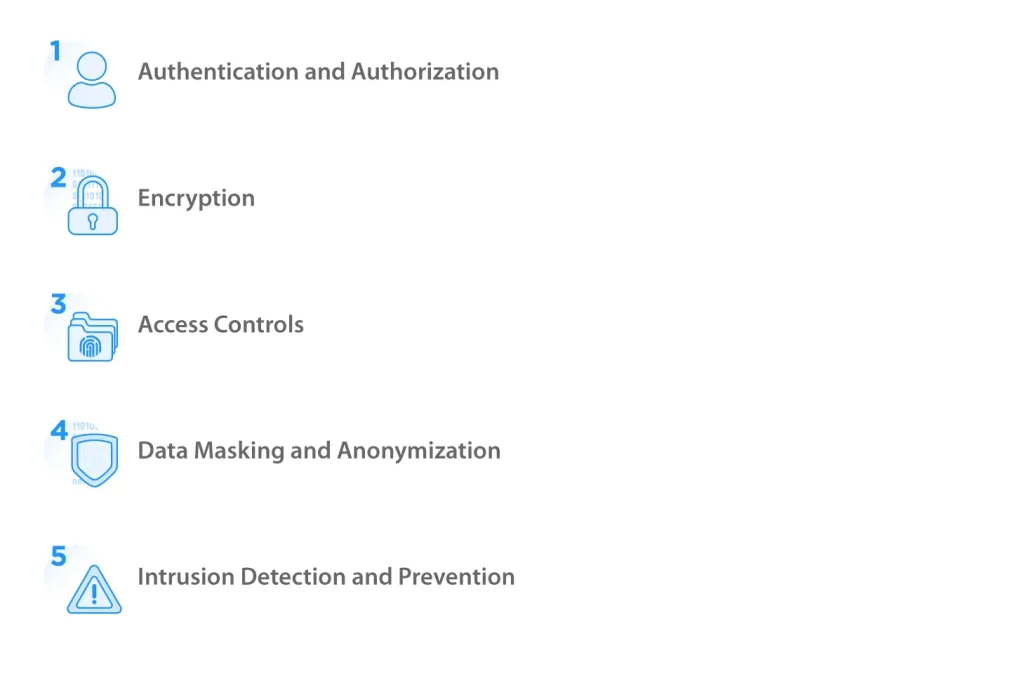
Security Architecture
Today, data breaches and cyber threats are ever-present risks. A robust security architecture is essential for protecting sensitive information stored in databases and data warehouses. Security architecture encompasses a comprehensive framework of measures designed to safeguard data integrity, confidentiality, and availability against unauthorized access, malicious attacks, and inadvertent breaches. In this article, we delve into the intricacies of security architecture tailored specifically for data and database protection, exploring key components, best practices, emerging trends in data security, and how DataSunrise can help there.
Understanding Security Architecture
Security architecture for data, databases, and warehouses comprises several interconnected components and layers, each playing a crucial role in fortifying the overall security posture. Here are some key components:

Picture 1. Key components of the Security Architecture
- Authentication and Authorization
Authentication mechanisms verify the identity of users accessing the data, while authorization controls define the level of access granted to authenticated users. Implementing strong authentication methods such as multi-factor authentication (MFA) and robust authorization policies helps mitigate the risk of unauthorized access.
DataSunrise offers two-factor authentication (2FA) as an additional layer of protection for accessing data and database resources to strengthen access controls and mitigate the risk of unauthorized access.
Real-time Activity Monitoring and Audit of database activities, allowing organizations to track and audit user actions, SQL queries, and data access patterns. By analyzing database activity logs, DataSunrise helps detect suspicious behavior, unauthorized access attempts, and potential security breaches in real-time, empowering organizations to respond promptly to security incidents.
- Encryption
Encryption is paramount for protecting data both at rest and in transit. Employing encryption techniques such as Advanced Encryption Standard (AES) for data encryption and Transport Layer Security (TLS) for securing data transmission ensures that sensitive information remains unintelligible to unauthorized parties, even if intercepted.
DataSunrise offers Format-Preserving Encryption (FPE) capabilities tailored to address the unique requirements of data protection in modern enterprises. DataSunrise’s FPE functionality enables seamless integration into diverse data environments without necessitating extensive changes to data formats or workflows.
- Access Controls
Granular access controls restrict access to data based on the principle of least privilege, ensuring that users only have access to the data necessary for their roles or responsibilities. Role-based access control (RBAC), attribute-based access control (ABAC), and fine-grained access controls enable organizations to enforce strict access policies and prevent unauthorized data access.
DataSunrise’s Access Control possibilities enable organizations to define and enforce fine-grained access permissions based on user roles, privileges, and contextual factors. Leveraging attribute-based access control (ABAC) and dynamic access policies, DataSunrise empowers organizations to restrict access to sensitive data, detect and prevent unauthorized activities, and maintain data confidentiality and integrity.
- Data Masking and Anonymization
Data masking and anonymization techniques obfuscate sensitive information in non-production environments, reducing the risk of data exposure during development, testing, or analytics activities. By replacing sensitive data with masked or anonymized equivalents, organizations can uphold data privacy while maintaining data utility.
DataSunrise offers Data Masking solutions that enable organizations to apply masking techniques such as tokenization, pseudonymization, and encryption to sensitive data fields. By masking sensitive data at the database level, DataSunrise helps organizations minimize the risk of data breaches, insider threats, and unauthorized access while maintaining data integrity and usability. Additionally, DataSunrise facilitates the implementation of data masking policies based on role-based access control (RBAC) and data sensitivity, ensuring that only authorized users have access to unmasked data.
- Intrusion Detection and Prevention
Intrusion detection and prevention systems (IDPS) continuously monitor data and databases for suspicious activities or unauthorized attempts to access or modify data. By promptly detecting and mitigating security incidents, IDPS helps prevent data breaches and unauthorized data tampering.
DataSunrise has a Database Firewall with built-in intrusion detection capabilities. By inspecting incoming SQL traffic and applying firewall rules, DataSunrise blocks unauthorized queries, SQL injection attacks, and other malicious activities targeting databases. Additionally, DataSunrise’s intrusion detection system (IDS) analyzes database activity patterns to detect and alert on suspicious behavior, helping organizations prevent data breaches and maintain regulatory compliance.
Best Practices for Security Architecture
Adhering to best practices in security architecture is essential for fortifying the resilience of data warehouses and databases against evolving cyber threats. Here are some recommended practices:
- Conduct Regular Security Audits
Perform periodic security audits and assessments to identify vulnerabilities, misconfigurations, and compliance gaps within the data and database infrastructure. Addressing identified issues promptly enhances the overall security posture and reduces the risk of security breaches.
- Implement Strong Encryption
Encrypt sensitive data both at rest and in transit using industry-standard encryption algorithms and protocols. Additionally, enforce encryption for database backups, archives, and replication to maintain data confidentiality across all stages of the data lifecycle.
- Harden Database Security Configuration
Follow security best practices provided by database vendors to harden the security configuration of database servers and instances. Secure default accounts, disable unnecessary services and features and apply patches and updates promptly to mitigate known vulnerabilities.
- Educate and Train Personnel
Provide comprehensive security awareness training to personnel handling data and database systems, emphasizing the importance of security protocols, data protection practices, and incident response procedures. Educated and vigilant staff are critical in maintaining a secure data environment.
- Implement Multi-Layered Defense
Deploy a multi-layered security approach comprising preventive, detective, and responsive controls such as firewalls, intrusion detection systems, security analytics, and incident response mechanisms. Combining multiple layers of defense strengthens resilience against diverse cyber threats.
Emerging Trends in Data Security
As cyber threats continue to evolve, several emerging trends are shaping the landscape of data security architecture:
- Zero Trust Architecture
Zero Trust Architecture (ZTA) adopts a holistic approach to security, assuming that no entity, whether inside or outside the network perimeter, can be trusted implicitly. By implementing strict access controls, continuous authentication, and micro-segmentation, ZTA minimizes the attack surface and enhances security posture.
- Homomorphic Encryption
Homomorphic encryption enables computations to be performed directly on encrypted data without decrypting it, preserving data privacy while allowing for secure data processing and analysis. This emerging encryption technique holds promise for protecting sensitive data in scenarios where data analytics and privacy are paramount.
- Blockchain-Based Data Integrity
Blockchain technology offers immutable and tamper-evident data storage, making it suitable for maintaining the integrity and provenance of critical data assets. By leveraging blockchain-based solutions, organizations can enhance data integrity, traceability, and auditability across distributed data environments.
Conclusion
In an era marked by escalating cyber threats and stringent regulatory requirements, security architecture plays a pivotal role in safeguarding the confidentiality, integrity, and availability of databases and warehouses. By adopting a comprehensive approach encompassing authentication, encryption, access controls, and intrusion detection, organizations can fortify their defenses against evolving cyber risks and maintain trust in their data assets.
By incorporating DataSunrise into their security architecture, organizations can enhance data protection, strengthen access controls, and mitigate security risks across their data and database infrastructure.
